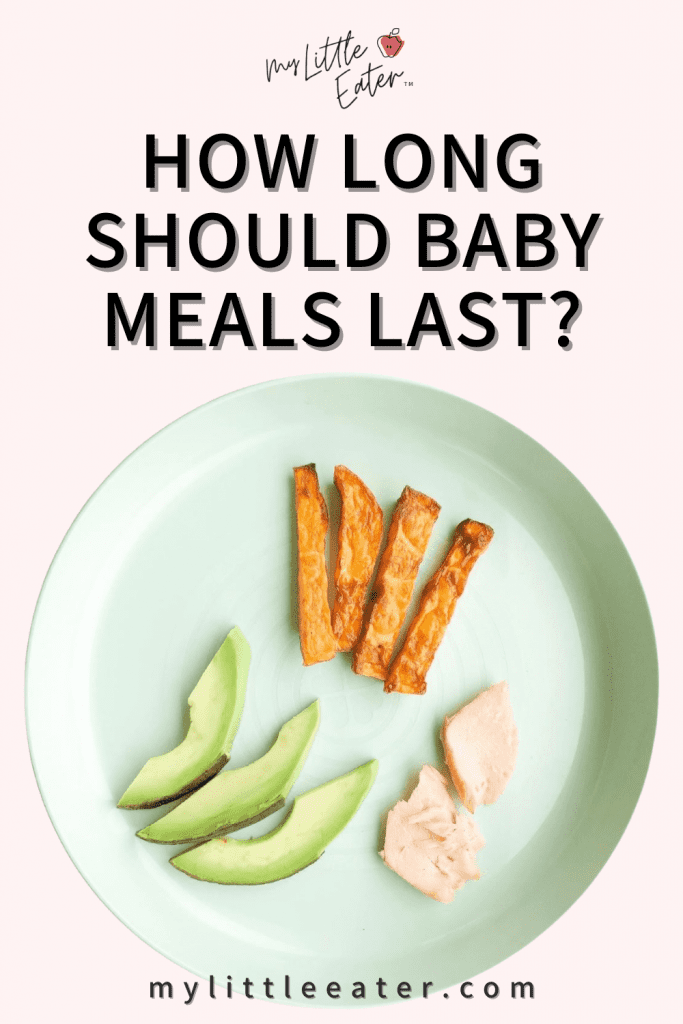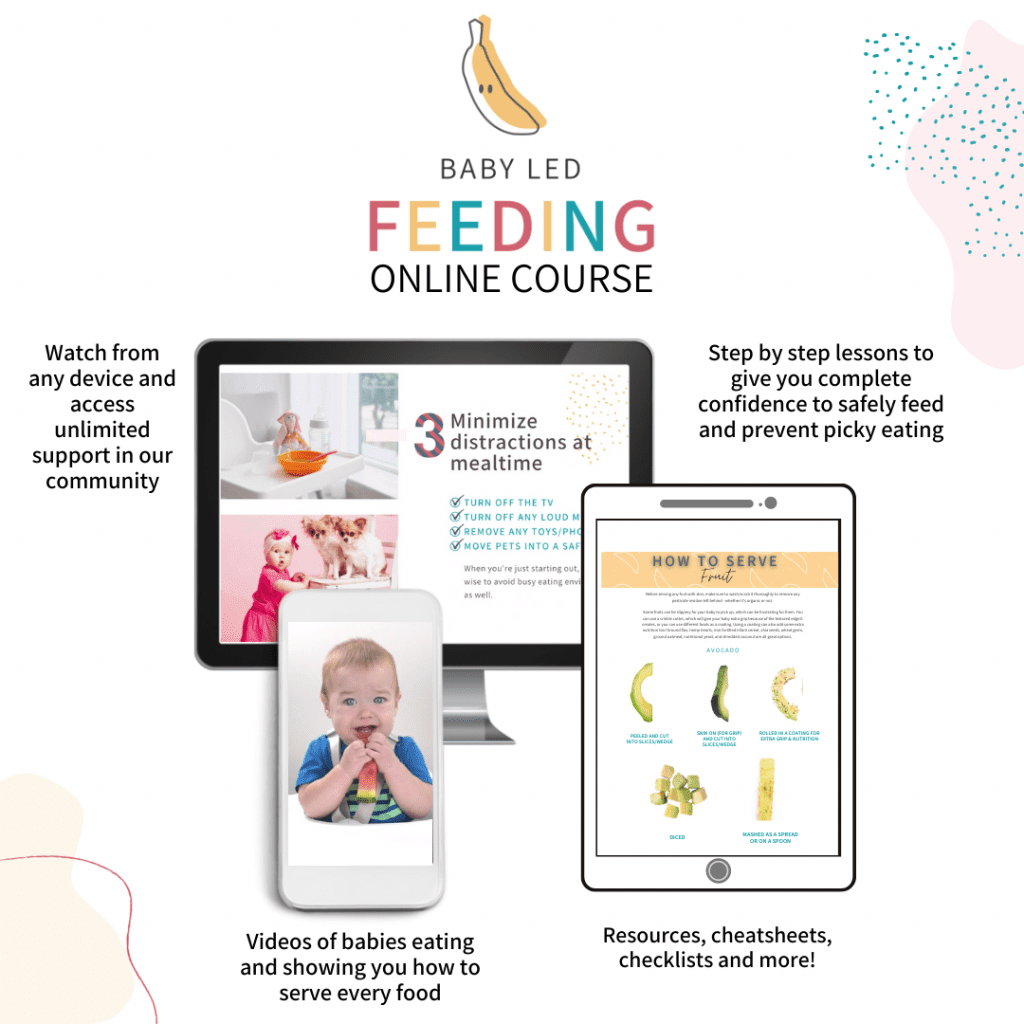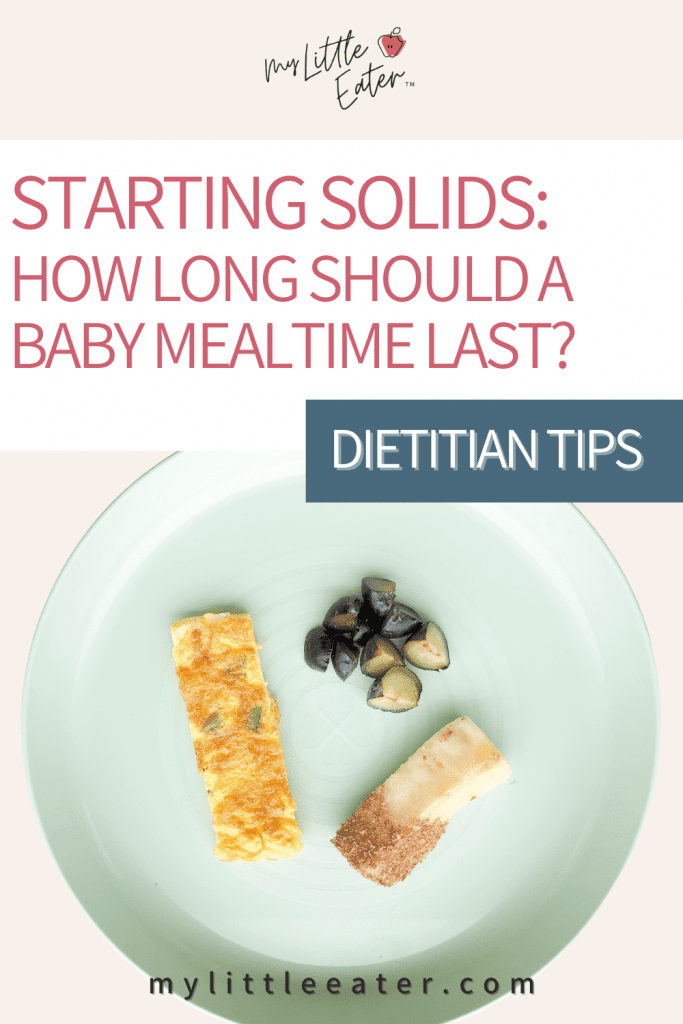As your baby learns how to eat solids, it’s going to take them lots of practice and time!
You might be wondering if it’s normal for your baby to sit and eat for 45 minutes. Or if it’s normal for them to seem disinterested in their food after only 5 minutes of being at the table.
How long should baby meal times actually last?
Well… there isn’t a one size fits all approach here and there are many factors to consider, so let’s discuss!
And just to note, I often find parents are concerned about how long meals last because it’s so closely linked with how much their baby is eating, which is a common worry! If you’re concerned about how much your baby should be eating at each meal, or what their portion sizes are, download our free guide to portion sizes below. It will give you peace of mind and clarity so you don’t have to question how much they’re eating again.

How long your baby takes to eat a meal can be sign that things are going right…or that there’s something wrong with how your baby eats. It could be a simple issue that’s fixed by simply trying again the next day, or it could be a sign that there is a underlying feeding difficulty or behavioral issue.
While of course, every baby is different (and every day can be different), we want to be able to understand the factors that go into how long it takes for your baby to eat a meal, and from them, optimize those factors to keep them thriving at the table.
Let’s break down the what you need to know about how long baby mealtimes should last.
What’s defined as mealtime?

Many parents actually end mealtime, pack up all the food and take baby out of the highchair once they stop taking bites of food. But mealtime isn’t just how long your baby is EATING. If they happily stay at the table and even just play or sit and observe while you’re eating, it’s actually beneficial to allow that, based on what’s reasonable for your schedule.
Some great reasons to keep baby at the table with you, even if they’re already done eating, include…
- Family time: creating memories for both you and baby
- Food play and exploration: let baby squish, feel and hold food for fine motor skill development (1)
- Learning through imitation: babies learn extremely well through imitation, so letting them sit and watch you eat is actually helping them develop their eating skills!
- Baby mealtime routines: Sitting at the table during family meals will gradually teach them what a mealtime routine looks like and what they can expect from day to day
How long should baby’s mealtime last?

Baby meal times generally last anywhere from 5-45 minutes. I know, that’s a huge spread but there are many factors that affect the length of mealtimes, including:
- Hunger levels
- Skill level
- Seating position
- Mood and fatigue
- Distractions
- Pressure
Typically, in the first couple of weeks of your baby starting solids, mealtimes may be shorter, where baby is learning how to eat and may only take a bite or two at best. Gradually, they learn to stay longer as their skills progress.
It’s best to give them at least 5 minutes, if possible, at most mealtimes to warm up to the idea that it’s time to eat and to sit with the family (or just you!) around the table. No need to worry if they don’t want to eat some meals, but keep them in the habit of sitting with you at scheduled times and at least watching you eat for a bit. This is helpful in the learning process.
Generally speaking, the upper limit for mealtimes should be around 45 minutes. Why? Babies “eating” consistently longer than around 45 minutes might not actually be eating. Usually they’re either:
- playing with food
- overly distracted during mealtime
- struggling with feeding and can’t get enough calories in during that time frame
You’ll learn more about red flags for when mealtime is taking too long towards the end of this post!
Factors that affect the length of baby mealtimes
Hunger levels

How hungry your baby is will be a big determining factor if they’ll be willing to sit in their high chair and eat a meal. You’ll want to avoid your baby coming to the table way too full or way too hungry, as both extremes could result in lack of interest during mealtime. Having a general routine and feeding schedule to follow will allow baby to come to the table slightly hungry, which in turn leads to acceptance of solid foods.
Babies don’t need to have a FULL belly all the time. Sometimes we push milk so baby doesn’t have the opportunity to have an empty stomach ever. Coming to the table with a full belly could result in baby showing no interest in the meal at all, which leads to a 5 minute meal consisting of zero to a few bites of food.
This in turn causes them to miss out on an opportunity to practice their eating skills and to get some extra nutrition. I recommend waiting at least 30 minutes, or even up to 90 minutes between milk feedings and solid foods to make sure baby is actually showing up to the table hungry.
On the other hand, if you’re waiting too long between milk feedings and offering solids, baby will end up coming to the table hangry (hungry and angry). A hangry baby may not be willing to stay and eat even though they need food. Learning how to eat solids takes practice, concentration and skills – and a hangry baby will not have the patience to concentrate enough to learn this new task.
If you want to learn more about tips for creating a feeding schedule and how often to feed your baby in the first year of starting solids, listen to my podcast, here.
Skill level

Learning how to eat is a skill just like any other! Babies need a lot of practice before they really get the hang of it. While they practice this new skill, it will take them longer to eat at some meals depending on if they’re exploring a new food, learning to use a new utensil or learning how to self feed.
Every baby is different, so it’s not possible to provide concrete recommendations of how long a meal should last based on skill level. Once they’ve been introduced to solids for a few weeks, babies learn more patience to sit and stay at the table for longer with more time and experience. As they learn they can fill up on solids, they’ll do so as skills progress. As opposed to early on where it’s mostly just exploring food for a brief amount of time, before baby gets bored and wants to get out. Every time a new food is offered, it’s another learning experience for them to explore, so expect that mealtime might be a little longer.
Another skill babies need time to master is learning how to use utensils. Meals may take a bit longer when utensils are first introduced. It’s best not to intervene to speed things up, as this won’t allow baby to have the practice they need to master this new skill. Some babies can get upset and frustrated when learning to use utensils, and may seem uninterested in eating if they’re struggling to use the utensil.
I know that many parents choose to start out by spoon feeding their babies, which is sometimes out of fear that their babies can’t get enough food or nutrition from self feeding. But until about 9 months of age, babies get all the nutrients they need from breastmilk or formula. So I promise there is no need to worry! And although spoon feeding can be much faster than letting baby self-feed, it doesn’t give them the opportunity to learn how to eat and won’t be helpful long term.
There are SO many benefits to self-feeding from a young age, so even if you do start out spoon feeding, you’ll want to watch for signs that your baby’s ready to become more independent in feeding and offer them the opportunity to try finger food. This promotes curiosity and independence to support positive mealtime experiences! Learn more by signing up for my free purées to finger foods workshop!
Seating position

The seating position and level of comfort your baby has in their highchair can affect how long mealtimes last.
Occupational therapists use the 90-90-90 rule for the best seating position for babies starting solids. Your baby should have a 90-degree angle at their hips, a 90-degree angle at their knees, and a 90-degree angle at their ankles while sitting in an infant high chair for baby led weaning or purées. To achieve a 90-degree angle at the ankles, babies need to have some sort of adjustable foot rest. This will provide them with core stability and will make it way more comfortable for them!
Try to see if you notice any discomfort or squirming during meals. If baby is uncomfortable while eating, they can quickly develop a negative association with mealtime. This can affect the length of time in which they’re willing to stay seated for a meal, which also impacts the amount of food they’re able to eat if they don’t want to stay seated for more than 5 minutes.
Again, if the amount of food your baby is consuming is a big worry, grab my free guide on how much your baby should be eating, below.
If you notice they’re uncomfortable in the high chair although they have an optimal seating position (including a foot rest), you can try using rolled up towels to fill any gaps between your baby’s back or hips and the chair. This helps prevent them from slipping and shifting around in the high chair during mealtimes.
Mood and fatigue

If your baby is overtired and fussy, they probably won’t be willing to sit in their high chair for anymore than 5 minutes without having a complete meltdown.
If you notice your baby is consistently coming to the table fussy and fatigued, my recommendation is to consider making changes to their eating and sleeping schedule. You may be offering solids too close to their nap time, which will result in mealtimes continuously getting cut short if baby gets too tired halfway through the meal, or before the meal even begins.
We want them to be alert and generally pleasant during mealtimes, not only for learning and food exploration, but because a baby that is falling asleep at the table is a safety hazard. There is an increased risk of choking if baby is not alert while eating.
If your baby is fussy during mealtime every once in a while, there’s no need to be concerned and start changing everything up – babies can get fussy for a million different reasons and they may just be having an off day. So if every meal isn’t a total success (which will happen and that’s totally ok), don’t stress as future eating opportunities will always be available in a couple hours.
Distractions during mealtimes

If you feel like your baby is taking forever to get through a meal, or they’re totally uninterested in the food you’ve offered, consider if there are any environmental factors that could be distracting them from the meal.
Things to consider that might be distracting your baby include:
- TV on during mealtime
- Ipads
- Toys or books in front of them
- A family pet hanging around while baby eats, waiting for yummy pieces of food to drop
- Music playing in the background
- Siblings trying to play with baby, acting out or being loud
Distracted eating can lead to under or over eating. Your baby may be forgetting to eat, as they might be so caught up in something else that they forget there is food right in front of them. Over eating is also possible if you use distractions, like a toy, to entice baby to take more bites.
So, how do you remove distractions during meal time? First identify what could be distracting your baby and then take it away, cold turkey if you can. Some would rather do it slowly using a step-by-step approach, so choose what works best for your family. Then you can start to use mealtime as a place for creating family connections, enjoying meals together and taking time to focus on the food, exploring and experiencing all of its unique characteristics.
Pressure from parents

Pressuring babies and toddlers to eat more (even light, unassuming pressure) can mean they either stay at the table longer to impress you, or want to leave sooner to avoid the stressful situation. Although it may not seem like pressure, sometimes parents will keep babies in the highchair for longer because they feel like their baby hasn’t eaten enough. But that just means we need to learn to 𝙏𝙍𝙐𝙎𝙏 our babies to eat what’s right for them vs. a predetermined amount we think they should be eating.
We also don’t want to be pressuring baby without knowing it – I mean keeping baby at the table longer because we don’t realize they’re telling us they’re all done with the meal or aren’t hungry anymore. Even though babies can’t communicate verbally, they’re still able to communicate using hunger and fullness cues. To learn your baby’s hunger and fullness cues and more about responsive feeding, check out my blog here.
If you’re feeling worried or concerned about how much your baby is eating, grab my free guide on portion sizes for babies!
Pressuring your little one to eat can be the root of many unnecessary mealtime battles. It can be really hard to do, but you can learn to take away meal time pressures by trusting baby to decide if and how much they eat, based on what their body needs. As long as you’re choosing what, when and where food is being served. This is also known as the division of responsibility.
Allowing babies to control if and how much they want to eat right from the start will help build trust between you and baby. They will learn that the parent is the one who decides what, when and where food is being served and that you’ll always be there to provide their next meal. Giving baby freedom to control how much they eat will help them learn how to identify hunger and fullness cues on their own, developing a healthier relationship with food long term.
How do I help my baby stay at the table longer?
Sit and eat with them

Engaging with your little one during meal time can make a big difference! To help your baby get more interested in their food and meal time, sit down and eat with baby. Pay attention to them, and sit in front of them where they can see you. I recommend eating with them too when you can, even if it’s just a few crackers. It will help model eating behavior and babies learn best from imitation.
To help your baby while they’re learning to eat, you can grab a piece of food and bring it to your mouth in a very exaggerated way. Bite down and show your baby how exaggerated your chewing is. You can also use your hands to show how your mouth opens and closes to chew.
Do this a few times, and then leave your baby alone to try it, without much more attention on them. For the rest of the meal, continue to just eat your own food. (Note: I don’t mean physically leave – they need to be supervised. Just don’t hover.)
Oftentimes, babies become overwhelmed when we give them too much attention, hover over them, and stare at them. Give them space and watch them from a distance while you just model how mealtime works yourself, or with the rest of your family.
What if my baby isn’t interested in solids or meal time?

In the early stages of starting solids, learning to eat can take longer for some babies than others, and they may not be interested right away, which is totally normal. It may be concerning if your baby doesn’t seem interested when they’re supposed to start solids, but it’s common for babies who are 6-7 months of age to be unsure of what to do with solid food. As you continue to offer your baby solids on a regular basis, you should start to see them get better and more efficient with eating solids as each month passes.
If you don’t see this progress happening, you’ll want to use the troubleshooting steps from my blog on top tips for when your baby won’t eat solids or shows no interest in food:
- Tweak the feeding schedule
- Are they getting too much milk at night?
- Is baby getting enough solid food practice?
- Are you eating with your baby?
- Offer food in new, big, and interesting ways
If your baby is still not showing interest in solids despite trying all these strategies for a month or two, or if your baby is past 9 months of age, seek out help from your doctor and ask for a referral for a feeding evaluation to rule out any medical or sensory issues.
Red flags for when baby mealtime is taking too long
In some instances, when baby meal times consistently take an hour or more, there could be something more serious going on. Pay attention and observe your baby while they’re eating to see if you can identify difficulties such as:
- Oral motor difficulties like struggling to chew certain foods/textures
- Swallowing difficulties
- Issues with fine motor skills, like being unable to pick up food and bring it to their mouth (most babies have mastered this skill by 9 months of age)
- Unable to grasp food because pieces are too small, too big or too slippery
(most babies develop their pincer grasp between 9-12 months)
If baby is unable to pick up and hold food because of its size or slippery texture, you can easily modify the food appropriately to coincide with their palmar grasp or pincer grasp. You can also roll slippery foods in something like shredded coconut or nutritional yeast to provide a better grip.
If your baby consistently takes longer than around 45 minutes to an hour during mealtimes and seems to be struggling with eating and it’s not getting better within a few weeks, it’s best to seek out help from your doctor and ask for a referral for a feeding evaluation to rule out any medical or sensory issues.
To learn more about how to prepare and serve foods based on your baby’s age and skill level, check out my Baby Led Feeding online course for everything you need to know! I’ll walk you through starting solids with your baby, step-by-step, using whichever method you feel comfortable with to start, and teach you how to gradually progress from there. Don’t spend this important milestone stressed out and worried – actually enjoy meals with your baby instead!

DID YOU FIND THIS HELPFUL? PIN IT TO SAVE FOR LATER!

References:
- Campeau, M., Philippe, S., Martini, R., & Fontaine‐Bisson, B. The baby-led weaning method: A focus on mealtime behaviors, food acceptance and fine motor skills. Nutrition Bulletin, 46(4), 476-485, 2021.

about the author
CHELSEY LANDRY, RD
Community Dietitian at My Little Eater Inc., and bunny-mom to Hickory. Chelsey offers one-on-one counselling to parents of babies and toddlers that need more customized support. Learn more by booking a free discovery call with her today!





